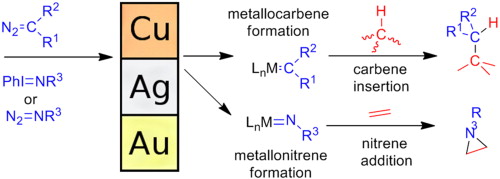Computational chemistry plays a key role in the construction of the current understanding of the reaction mechanisms for the reaction of coinage metal complexes with hydrocarbons. Carbene precursors (diazo compounds) or nitrene precursors (hypervalent iodine compounds or azides) react with the catalyst complexes giving rise to highly reactive metallocarbene or metallonitrene intermediates, which are difficult to observe experimentally. DFT calculations allow the characterization of these intermediates and of their reactivity with hydrocarbons, leading to C–H insertion, aziridination or oxazole synthesis. This review summarizes computational work in the last decade in this research field, which has progressed in collaboration with experimental knowledge on these systems.
